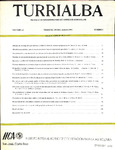
Please use this identifier to cite or link to this item:
http://ricaxcan.uaz.edu.mx/jspui/handle/20.500.11845/1134Full metadata record
| DC Field | Value | Language |
|---|---|---|
| dc.contributor.other | 0000-0002-7258-3618 | es_ES |
| dc.contributor.other | https://orcid.org/0000-0002-7258-3618 | - |
| dc.coverage.spatial | Zacatecas, México | es_ES |
| dc.creator | Salinas, H. | - |
| dc.creator | Avila, A. | - |
| dc.creator | Falcón Ramos, José Antonio | - |
| dc.creator | Flores, R. | - |
| dc.date.accessioned | 2019-09-24T14:41:29Z | - |
| dc.date.available | 2019-09-24T14:41:29Z | - |
| dc.date.issued | 1991-01 | - |
| dc.identifier | info:eu-repo/semantics/publishedVersion | es_ES |
| dc.identifier.issn | 0041-4360 | es_ES |
| dc.identifier.uri | http://ricaxcan.uaz.edu.mx/jspui/handle/20.500.11845/1134 | - |
| dc.identifier.uri | https://doi.org/10.48779/ck7y-mn56 | - |
| dc.description | The systems approach methodology was used to ldentify, describe and analyze the main fazctors limiting goat production systems In the State of Zacatecas, Mexico. After a survey and analysis of secondary lnformation, four distrlcts were selected, representlng 5O% or the State's goat population; the four dlstrlcts were regrouped into three different agrocllmatlc areas: one (Concepcion del Oro) was the mostarid and was oriented toward the productlon of baby kids (milk-fed), while the other two (Ojocaliente and Zacatecas) enjoyed more ralnfall and availabillty or feed; thelr system consisted of the production of does, marketed for thelr meat and consumed as "birria" (a sort of stew). Based on a static diagnosis or 151 farms (representing no less than 10% or the total number or farms), it was posslble to reconfirm the exlstence or the above-mentloned produdlon systems. Both systems co-exlst wlth rain-fed crops (corn and beans), although these were high-rlsk In Concepclon del Oro. Ali farmlng activities depended on family labor (less than 18% offarmers hired outside laborers). | es_ES |
| dc.description.abstract | Se aplicó la metodología del enfoque de sistemas para Identificar, describir y analizar los principales factores limitantes de los sistemas de producción caprina en el estado de Zacatecas (México). Después de un sondeo y análisis de la Información secundarla, se seleccionaron cuatro distritos que representaban el 5O% de la población caprina estatal; los que se redistribuyeron en tres áreas de características agroclimátias distintas: Concepción del Oro, la más árida y coincidente con un sistema de producción de cabritos de leche; Ojocaliente y Zacatecas, de mayor precipitación y disponibilidad de recursos alimentarios y orientadas a la producción de animales adultos para el consumo en forma de "birria" -cocido de carne de cabra adulta. Con base, en una encuesta estática de 151 prosadores - no menos del 10% del universo comprendido en los cuatro distritos - se corroboró la existencia de los dos sistemas indicados anteriormente. Ambos sistemas conviven con agricultura de temporal -maíz y frijol aunque con más riesgo en Concepción del Oro. Todas las actividades dependen de la mano de obra familiar - menos del 18% de los productores contrata mano de obra. | es_ES |
| dc.language.iso | spa | es_ES |
| dc.publisher | Instituto Interamericano de cooperación para la agricultura | es_ES |
| dc.relation.uri | generalPublic | es_ES |
| dc.rights | Atribución-NoComercial-CompartirIgual 3.0 Estados Unidos de América | * |
| dc.rights.uri | http://creativecommons.org/licenses/by-nc-sa/3.0/us/ | * |
| dc.source | TURRIALBA, Revista Interamericana de Ciencias Agrícolas, Vol. 41, No. 1, Trimestre enero-marzo | es_ES |
| dc.subject.classification | CIENCIAS AGROPECUARIAS Y BIOTECNOLOGIA [6] | es_ES |
| dc.subject.other | caprinos | es_ES |
| dc.subject.other | Zacatecas | es_ES |
| dc.subject.other | goats | es_ES |
| dc.title | Factores limitantes en el sistema de producción de caprinos en Zacatecas | es_ES |
| dc.type | info:eu-repo/semantics/article | es_ES |
| Appears in Collections: | *Documentos Académicos*-- UA Enfermería | |
Files in This Item:
| File | Description | Size | Format | |
|---|---|---|---|---|
| 2019_09_19_09_02_27.pdf | 2,62 MB | Adobe PDF |  View/Open |
This item is licensed under a Creative Commons License
